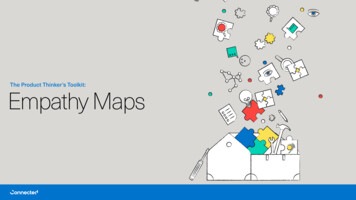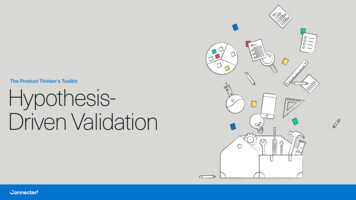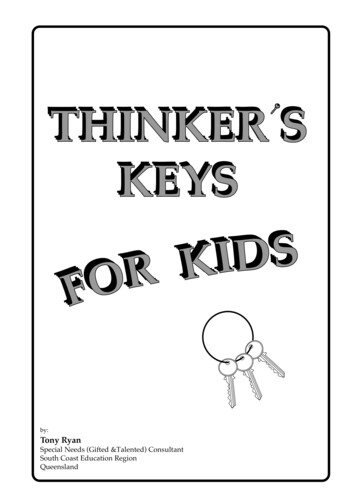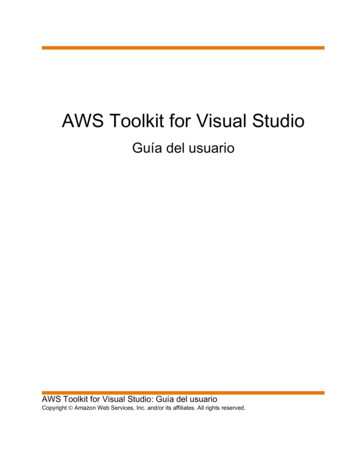
Transcription
The Product Thinker’s Toolkit:Empathy Maps
The Product Thinker’s Toolkit: Empathy MapsProduct development is hard.In a world of software, meaningful differentiation that delivers valueto customers is critical to organizational progress, and that is whatProduct Thinking is designed to do. The Product Thinking approachbrings together key disciplines, mental models, and methodologiesto build better products, leading to supercharged product teams, anaccelerated product vision, and revenue-driving products.But to be effective, a Product Thinker’s toolkit needs to be robust—filled with frameworks one can pull from at the right moment tounlock product impact. Here we look at a Connected favourite thatwe’ve used time and time again for both discovery and deliveryengagements: empathy maps.
The Product Thinker’s Toolkit: Empathy MapsWhat is an empathy map?An empathy map is a collaborative visualization tool that articulateswhat we know about a particular type of customer and createsa shared understanding among the core product developmentteam. Traditionally, a design thinking empathy map consists of fourquadrants—think & feel, see, say & do, and hear—with the type ofcustomer in the middle. However, a Product Thinking empathy mapincludes a fifth step: other personas/multiple maps.An empathy map is most commonly used during the discoveryprocess, often as early as during a kickoff workshop or prior to userresearch. Yet by applying the Product Thinking approach, empathymapping can be used at any time in the product developmentprocess. During discovery, the tool allows a team to ideate andexplore based on what it knows and doesn’t know about itscustomers. In delivery, though, empathy maps can bring the teamback to the core problem the product is meant to solve and groundall building activities in the customer’s wants and needs.
The Product Thinker’s Toolkit: Empathy MapsWhy use them?Empathy maps allow a product development team to gain aclearer understanding of its target customers and ensure thatthe final product is built around real-world wants and needs.They achieve this by:— Allowing a product development team to surface its hunches andassumptions about customers prior to research, which helps guideresearch efforts— Providing a clear framework for synthesizing customer researcharound insights specific to how customers will truly perceive theproduct— Offering a product development team a reusable framework forboth pre- and post-launch and enabling the team to continuallyembed new insights into the development process
The Product Thinker’s Toolkit: Empathy MapsHow to use themWhat follows is a high-level walkthrough of the six steps involved inempathy mapping.
The Product Thinker’s Toolkit: Empathy Maps01The customerYour target customer is in the heart of an empathymap. You should list everything you currently knowabout your customer—demographics, interests,volume, and so forth—and the situation your productwill be built for. The aim is to focus everyone in theroom on whom you’re designing for. If this is preresearch, then it’s okay for the information to bevague, but you should note gaps in your knowledge.If this is post-research, you should include insightsas well as statistics.
The Product Thinker’s Toolkit: Empathy Maps02Think and feelThe first quadrant asks you to consider what thecustomer is thinking and feeling. It’s important toframe up the differences between both but alsoconsider how they relate to one another. Whenwriting in this quadrant, it should be as if you’rewriting out a quote from the customer—e.g.,thought: “I wish this task was simpler”; feeling:“I’m frustrated that this takes so long.”
The Product Thinker’s Toolkit: Empathy Maps03SeeThe second quadrant asks you to consider whatthe customer sees. If you’re in a discovery phasefor an entirely new product, this quadrant will referto the current solutions or lack of solutions on themarket. If you’re working on a prototype or evolvingan established product, you should focus on thespecific details of the product and what draws thecustomer’s eyes—e.g., “I love the simple drop-downmenu,” or “The illustrations are fun.”
The Product Thinker’s Toolkit: Empathy Maps04Say and doThe third quadrant asks you to consider what thecustomer says and does. It’s important to recognizethe distinction between the two responses. Whata customer says will reveal clear pain points oraspirations they have when using the product—e.g.,“I wish I could just speak to a sales rep,” or “I thinkthis is a great tool for improving my productivity.”What a customer does will reveal their true use ofthe product—e.g., “returns to the home screen whenthey’re unsure of where to go” or “only uses mainfeatures after quickly browsing extra features.”
The Product Thinker’s Toolkit: Empathy Maps05HearThe fourth quadrant asks you to consider what thecustomer hears elsewhere. This calls into questionhow you hope or assume your product/productconcept is perceived. In a discovery phase, you canbe aspirational—e.g., “They say it’s easy to use andcollaborative.” If you’re testing a prototype or evolvinga product, you’ll be recording what you already knowor perceive, whether positive or negative—e.g., “Ihear it’s great when it works, but it’s glitchy,” or “afriend of mine told me it’s a lifesaver for them.”
The Product Thinker’s Toolkit: Empathy Maps06Other personas/multiple mapsThe final step is acknowledging that certain products must factor in other personasalongside your target customer. The aim here isn’t to dilute your empathy map.Instead, it is to build out an image of other stakeholders who might influence thepath to purchase/download/use. For example, your target customers for an in-storeAI grocery assistant might be young professionals, but ignoring the important role astore manager and staff play in adoption will lower your product’s impact.You may also have multiple target customers that you’re looking to design for. If youneed to understand stakeholders or a wider group of target customers, repeatingthe above steps and clearly marking the role of each empathy map in your productdevelopment process will help you build empathy for all the people your product willimpact. As with all great Product Thinking, you shouldn’t be afraid to evolve, improve,test, and learn until you’ve built the right thing right.
The Product Thinker’s Toolkit: Empathy MapsWe enable faster timeto-market, with higherproduct success arnersConnected is a software product development firm.We partner with ambitious companies across the entireproduct development lifecycle, helping deliver new productsthat users love at pace and scale.Our Product-Thinking approach works because we solvefor desirability, viability, feasibility, and usability together, notseparately. We do this by bringing engineers, strategists, anddesigners together, blending discovery and delivery activitiesto keep a razor-sharp focus on building impactful products.With a mission of building better products, our approachand the tactics, techniques, and models we employ areall designed to deliver on that mission for our clients.Our ServicesDiscoveryDeliveryEducation & EnablementDiscovery serves to derisk,validate, and accelerate newproduct development. By viewingcustomer jobs, pains, and gainsthrough the lens of product, weare able to identify opportunitiesin both new and existingcategories, before testingconcepts through prototyping.Delivery allows us to partner withour clients to build and releasehigh-quality products to market, aswell as optimize and scale existingproducts. Because softwareproducts are never finished.Education & Enablementis designed to embed aproduct DNA into our clients’organizations, educate themon the Product Thinking bestpractices, and empower thecreation of their own long-termsystems of success throughworkshops, product clinics,and training sessions.Learn more at edioconnectedio
The Product Thinker’s Toolkit: Empathy Maps Product development is hard. In a world of software, meaningful differentiation that delivers value to customers is critical to organizational progress, and that is what Product Thinking is designed to do. The Product Thinking approach brings t










